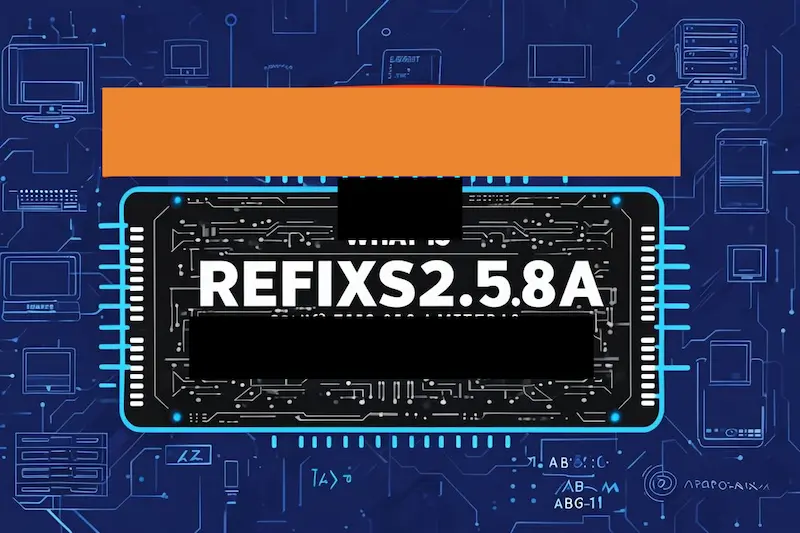In the dynamic tech ecosystem of 2025, refixs2.5.8a emerges as a pivotal framework, revolutionizing how software tackles performance challenges. This cutting-edge tool, blending adaptive intelligence with streamlined design, is redefining efficiency across diverse applications, from fintech to immersive gaming.
The Foundation of refixs2.5.8a
At its heart, refixs2.5.8a is a versatile optimization engine crafted to enhance software functionality. Unlike rigid legacy systems, refixs2.5.8a dynamically adjusts to real-time demands, making it perfect for high-stakes environments like real-time analytics or augmented reality. Its name—merging “refine” and “fix” with a version marker—signals its iterative approach, constantly evolving to meet modern needs.
Born from the need to overcome bottlenecks in traditional software, refixs2.5.8a offers a modular structure that integrates seamlessly with existing platforms. Its ability to minimize latency while maximizing throughput has positioned refixs2.5.8a as a go-to solution for developers seeking agility without compromising reliability.
The Mechanics of refixs2.5.8a
The strength of refixs2.5.8a lies in its intelligent, layered architecture, designed to deliver peak performance with minimal overhead.
Core Operations of refixs2.5.8a
The framework operates through a three-step cycle: assessment, optimization, and implementation. It begins by analyzing system metrics, pinpointing inefficiencies like memory overuse or processing delays. Next, refixs2.5.8a deploys adaptive algorithms to reallocate resources, prioritizing critical functions. Finally, it executes changes in real time, ensuring seamless performance.
Standout features include its smart resource allocator, which anticipates workload shifts, and a flexible API that supports languages like Python and Go. In fintech, refixs2.5.8a optimizes transaction processing, reducing delays by up to 20%. Its customizable modules allow developers to tailor refixs2.5.8a for specific tasks, from cloud orchestration to mobile app streamlining.
Advanced Capabilities of refixs2.5.8a
What elevates refixs2.5.8a is its machine-learning-driven core, which refines performance based on usage patterns. This self-improving system ensures long-term gains, with efficiency increasing over time. Its broad compatibility—spanning IoT devices to enterprise servers—makes refixs2.5.8a a universal powerhouse.
Why refixs2.5.8a Matters
The benefits of refixs2.5.8a are transformative. It slashes energy use, critical for sustainable tech like edge computing, with tests showing up to 35% reductions in power consumption. Scalability is another strength; refixs2.5.8a maintains stability during traffic surges, making it ideal for high-demand applications.
Reliability shines through in performance metrics, with refixs2.5.8a-powered systems achieving near-zero downtime in rigorous testing. Its adaptability ensures it evolves with emerging technologies, keeping refixs2.5.8a relevant in a fast-changing landscape.
Real-World Applications of refixs2.5.8a
The framework’s versatility drives impact across sectors. In gaming, refixs2.5.8a enhances multiplayer experiences by optimizing server response times, delivering lag-free gameplay. Healthcare systems use it to streamline data processing for real-time diagnostics, speeding up patient care. E-commerce platforms leverage refixs2.5.8a to power personalized recommendation engines, boosting conversions without straining servers.
Startups benefit from its lightweight design, enabling rapid development on lean budgets. In logistics, refixs2.5.8a refines delivery algorithms, adapting to variables like road conditions, saving time and fuel.
Navigating Challenges with refixs2.5.8a
Adopting refixs2.5.8a isn’t without hurdles. Its advanced features may intimidate newcomers, but extensive documentation and community support ease the transition. Older systems may resist integration; phased rollouts address this, allowing gradual adoption.
Over-optimization risks inefficiencies, but refixs2.5.8a’s monitoring tools help developers calibrate settings for optimal balance. Starting with small-scale trials ensures smooth scaling, minimizing disruptions.
Conclusion
The refixs2.5.8a framework is a catalyst for innovation, blending adaptive intelligence with robust performance to redefine software optimization. From gaming arenas to healthcare hubs, refixs2.5.8a empowers developers to build smarter, faster, and greener solutions. As technology races forward, refixs2.5.8a lights the path, proving efficiency is the key to unlocking a connected future.



